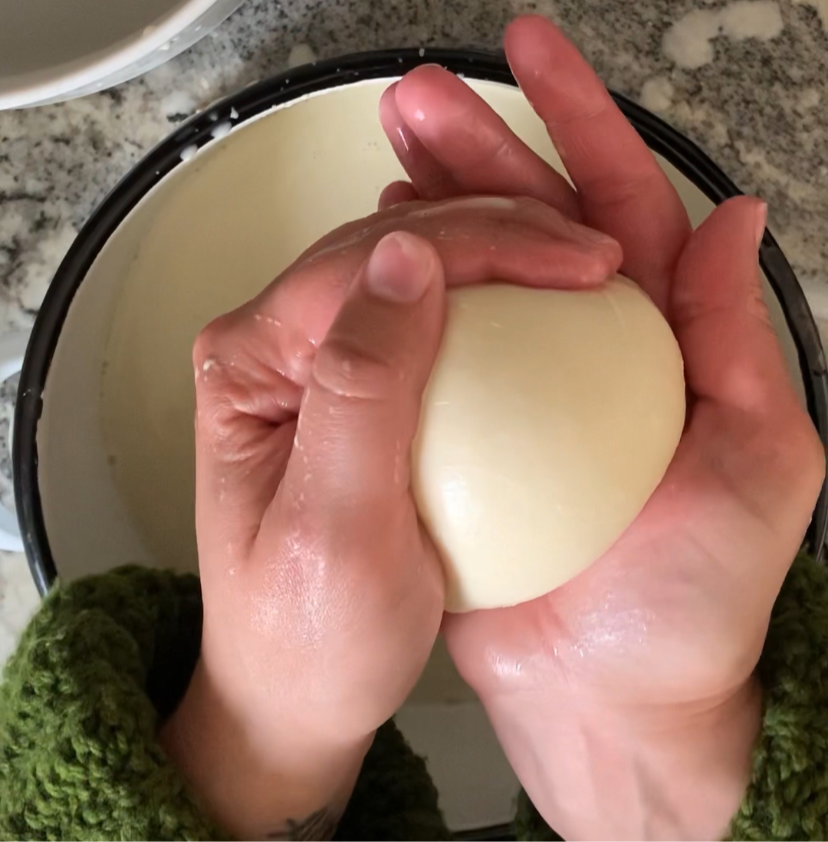Elevate Family Pizza Night With This Homemade Sourdough Pizza Crust
- Cara Russell Buckner

- Feb 7, 2023
- 5 min read
Updated: Mar 15, 2024

Homemade Family-Sized Sourdough Pan Pizza: Half pizza is , black olives and cherry tomatoes. The other half is classic pepperoni.
When I was a kid, sometimes for dinner, my mom would make a huge rectangular pan pizza loaded with toppings for my dad, my brothers, and me. Decades later, when I started making sourdough pizzas for my family, I immediately set out to reconnect with some of that nostalgia from my childhood. The pizza had to be rectangular, and it had to be bubbly, like focaccia bread. In my desire to move away from buying things in a box, or commercial yeast, I knew sourdough was the only kind of pizza crust I wanted to make.
These days it's all about that wild yeast, sourdough. People love the tangy flavor, the chewy crust, and the simplicity of just a few ingredients. The popularity with sourdough is showing no signs of slowing, and once you've tried a sourdough pizza crust that you made yourself, there's a very high probability that you will never go back to takeout, delivery, frozen, from a box, or store-bought yeast for pizza night again.
I have made this sourdough pizza recipe dozens of times, and I have shared many of them on social media. My large 15 x 21 inch bubbly pizzas have made an impression. Now, many of you have commented on my videos that it's now your family's favorite pizza crust as well. This warms my heart. And more than enough of you have asked for the recipe to be more accessible in blog form. It's been a minute, but here it is. Thank you for waiting.
It's only been 2 hours and my kids want to eat that pizza asap lol –Lilly

Weighing Ingredients over measuring:
Weighing ingredients provides greater accuracy, consistency, and precision in baking, which is why it's often preferred, especially in more precise recipes like sourdough bread, where fermentation and gluten development are critical factors.
1. Consistency and Accuracy: Weighing ingredients provides more consistent and accurate results. The weight of an ingredient remains constant, while the volume of an ingredient can vary depending on how tightly it's packed or how it's scooped. Variations in density can lead to inconsistent results.
2. Easily Scale Recipes Up Or Down: When scaling recipes up or down, weighing ingredients is much easier and more accurate than trying to adjust volumetric measurements.
3. Reduction of Cleanup: Weighing ingredients means fewer utensils and measuring tools to clean up compared to using measuring cups, which can make the baking process more efficient.
A Healthy Sourdough Starter Matters:
*If you don’t already have a sourdough starter, here’s my recipe on How To Cultivate Sourdough Starter.
Maintaining a healthy sourdough starter is crucial for sourdough pizza making. A healthy starter is full of active yeast and beneficial bacteria, which add a tangy taste and improve dough structure and leavening. The live cultures in a well-fed starter aid in breaking down carbs for better digestibility and nutrition. By regularly nurturing and feeding the starter, you will achieve delicious sourdough pizza crusts that are crisp, bubbly, and have that popular distinctive tangy flavor.
Storage and Reheating: Leftover sourdough pizza can be stored in the refrigerator for a few days or frozen for longer-term storage. To maintain its freshness and flavor when reheating, a hot skillet or oven works best to crisp up the crust and ensure that toppings are heated through evenly. Avoid using the microwave, as it can result in a soggy crust. But, pizza is good either way, even cold.
Leftovers Are Healthier: Eating leftover carbs, like cold pizza, can benefit gut health and reduce calorie absorption due to resistant starch and retrogradation. They improve blood sugar control and insulin sensitivity, good for those with diabetes or insulin resistance. They also promote feelings of fullness. And, they act as prebiotics, supporting digestive health. Additionally, they can improve lipid profiles, contributing to better metabolic health.

Elevate Family Pizza Night With This Homemade Sourdough Pizza Crust
(Makes enough for one 15 x 21 inch pizza)
Pizza Crust: Supplies
Mixing Spoon or Dough Whisk
Wet towel or Bowl Cover

Pizza Crust: Ingredients
500 grams unbleached flour (I use all purpose)
350-400 grams water (start with a lower hydration for easier handling)
100 grams sourdough starter
6-10 grams salt
10-20 grams olive oil (optional)
Pizza Crust: Directions Two Ways
Optional One: Mix flour and water and autolyse 60 minutes, then add remaining ingredients and mix. The enzymes naturally present in the flour get a head start with gluten development and begins breaking down starches and proteins. Autolyse help to improve your dough's finished texture for a more flavorful and airy crust and crumb
Option Two: add all ingredients at the beginning and skip the autolyse.
Dough will look shaggy at the start.
Keep dough in a warm location, stretching and folding every hour for 4-6 hours. Keep dough covered between stretching. Look for bubbles and doubling of dough. The dough will become les shaggy and more smooth, elastic, and easy to work with after every stretch.
24 Hour Pizza Dough: Place covered dough still in the bowl into the fridge overnight to slow down fermentation. Around 12 hours. This step also helps improve the flavor and texture of your sourdough.
8 Hour Pizza Dough: If you’re low on time you can skip the cold fermentation, and bake your pizza dough the same day you started it. But, with the cold fermentation you do get a more complex flavor, better gluten development, and a more digestible pizza crust. But, when you're in a hurry, this eight hour crust will still taste amazing.
Stretch out dough on baking tray coated with olive oil. And I mean coated. This will keep the dough from sticking and add a nice crunch. You can also use cornmeal if you don't want to use oil. You can also purchase a non stick baking pan.
Add pizza sauce onto your stretched out dough. Adding your pizza sauce at this stage helps the crust not dry out during the first bake in the oven.
Bake crust with pizza sauce spread over at 450 degrees Fahrenheit (232 degrees Celsius) for 10-15 minutes.
Remove from the oven and add your favorite toppings and more sauce if you like it saucy. Skip the pre shredded cheese you can get at the store. It’s coated in anti caking agents like cellulose and corn starch, which can affect the texture and the way the cheese melts.
Bake another 15-18 minutes.
Enjoy your pizza!























Comments